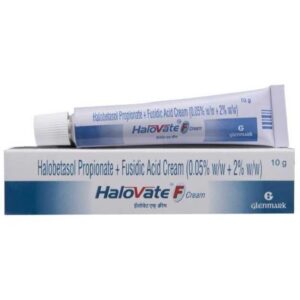FUSIDIC ACID + HALOBETASOL PROPIONATE
Fusidic Acid: Fusidic acid is a medication commonly used to treat bacterial infections. It belongs to a class of drugs called antibiotics and acts specifically against gram-positive bacteria. It works by binding to a bacterial protein called elongation factor G (EF-G), which inhibits the synthesis of proteins essential for bacterial growth.
Fusidic acid is primarily used to treat skin infections, such as impetigo, infected dermatitis, and infected wounds. It can also be used in combination with other antibiotics to treat more severe infections, such as osteomyelitis and endocarditis.
When used topically, fusidic acid is usually applied to the affected area two to three times a day. For systemic infections, it is typically administered orally or intravenously. The dosage and duration of treatment depend on the severity of the infection and individual factors, so it is important to follow the instructions provided by a healthcare professional.
As with any medication, fusidic acid can cause side effects. The most common side effects include irritation and burning sensation at the application site, itching, and skin rash. These side effects are usually mild and resolve on their own. Less commonly, systemic use of fusidic acid may cause gastrointestinal disturbances like nausea, vomiting, and diarrhea.
It is important to note that fusidic acid should be used with caution in patients with a history of liver disease, as it can cause hepatic dysfunction. Additionally, prolonged use of fusidic acid or its combination with other drugs may increase the risk of developing antibiotic resistance. Therefore, it is necessary to use fusidic acid as prescribed and only for the recommended duration of treatment. It is always advisable to consult a healthcare professional for specific advice regarding the use of fusidic acid.
Halobetasol Propionate: Halobetasol Propionate is a potent topical corticosteroid medication. It is primarily used to treat inflammatory skin conditions such as eczema, psoriasis, and dermatitis. Halobetasol Propionate works by reducing inflammation, redness, and itching associated with these skin conditions.
The drug is available in the form of a cream, ointment, or lotion and should be applied sparingly to the affected area. It is usually recommended to apply a thin layer once daily for a limited duration, as directed by a healthcare professional. It is important to follow the prescribed dose and duration of treatment to avoid potential side effects.
Common side effects of Halobetasol Propionate may include burning or stinging at the site of application, skin itching or irritation, dryness, redness, and thinning of the skin. In rare cases, it may cause skin discoloration, acne, or excessive hair growth. Prolonged use or misuse of the drug can lead to systemic absorption, increasing the risk of systemic side effects such as adrenal suppression, Cushing’s syndrome, or other hormonal imbalances.
It is crucial to follow the instructions provided by your healthcare provider and not to use Halobetasol Propionate on broken or infected skin or on the face unless specifically instructed to do so. It should not be used for extended periods or in excessive amounts, as it can have detrimental effects on the skin and overall health.
It is important to note that Halobetasol Propionate is a prescription medication, and it is necessary to consult a healthcare professional before starting or stopping the treatment. They will evaluate the specific condition and medical history to determine the appropriate dose, duration, and frequency of use to achieve the best therapeutic response while minimizing the risk of side effects.

